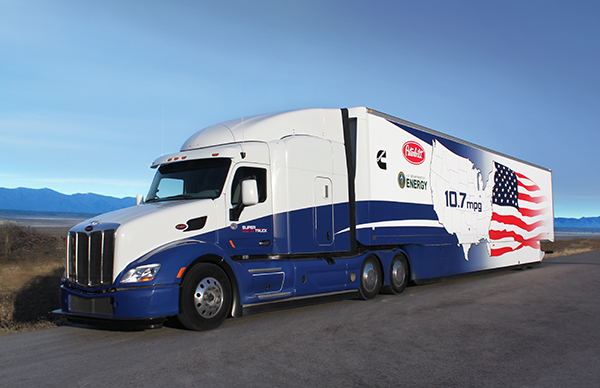Last month, we announced that new fuel economy and global warming emissions standards could reduce fuel consumption from heavy-duty trucks by 40%. Today, we are releasing a fact sheet that highlights some of the ways we can reach that target if we take action on trucks. You can follow the conversation on Twitter to see how we plan to #ActOnTrucks.
Trucks do a lot of work—and use a lot of fuel
Heavy-duty vehicles range from heavy-duty pick-ups to delivery vans to buses and tractor-trailers. While they combine for just 7% of the vehicles on the road, they consume 25% of the fuel, due in large part to the literally tons of people and goods transported. Two-thirds of this fuel is used by the trucks that are probably the most familiar and iconic, tractor-trailers.

Innovations like those demonstrated through the Department of Energy’s SuperTruck program can help reduce fuel usage from line haul tractor-trailers by almost 50% compared to a 2010 tractor-trailer. (Photo courtesy of Cummins, Inc.)
Technology can help reduce that fuel usage
Our analysis looked at a wide variety of technologies to reduce fuel usage from heavy-duty trucks, from those that are starting to become more widely available today to those that have only been demonstrated in advanced demonstration projects like the Department of Energy’s SuperTruck program.
We see lots of opportunity for improved efficiency. Automated manual transmissions can keep the engine operating at the most efficient speeds, blending the efficient shifting of a manual transmission with the sophisticated controls of an automatic.
Technologies developed for the engine such as waste heat recovery can make the engine more efficient as well, in this case by utilizing heat that would otherwise be lost to exhaust. And all of this is in addition to load reduction strategies such as improved trailer aerodynamics and low-rolling resistance tires, which can significantly reduce the amount of energy needed to power a vehicle.

Hydraulic hybrid vehicles like this garbage truck now deployed in Miami are one of the many ways to reduce fuel consumption from heavy-duty trucks. (Photo courtesy of Parker Hannifin Corp.)
For vocational vehicles, which range from delivery vans to dump trucks, one of the technologies that could lead to some of the strongest reductions is hybridization.
Hybrid applications are best aimed at vehicles with lots of stop-and-go behavior and vehicles that use a lot of fuel to power external devices, such as utility trucks or refuse trucks. For example, garbage trucks not only stop and start more frequently than any vehicle on the road, but fuel is also consumed even when the vehicle is not moving in order to power the compaction device. In an application like this, energy can be stored on board, either from a battery (in the case of a hybrid-electric) or through a pneumatic fluid (in the case of a hydraulic hybrid), and then used to “launch” the vehicle during stop-and-go operation.
Just like with bucket trucks, where you can use a battery to power the vehicle’s on-site work, there is also an opportunity to reduce fuel usage by using a battery-powered electrified compaction unit. Though expensive, in the right application, hybrid vehicles such as these can provide a significant opportunity to reduce fuel usage over the lifetime of a vehicle.
These technologies can be cost-effective as well
While there are numerous technologies that can be employed, one of the questions we looked at in our analysis was what technologies would also be cost-effective. After all, it is important that these standards drive innovation that will benefit the users of these vehicles.
Given this consideration, we found that our suite of technologies could be applied to tractor-trailers and pay for themselves in fuel savings in just over a year! And while pick-up trucks and vocational vehicles travel significantly fewer miles and therefore take a little bit longer to recoup the investment costs, we found that even hybrid vocational vehicles can pay for themselves in less than 100,000 miles, well below the lifetime of these vehicles.
Standards are necessary to help drive down emissions and oil usage
By helping to drive technologies into the market to provide consumers with new, cost-effective solutions to reduce fuel consumption, fuel economy and global warming emissions standards for heavy-duty vehicles could reduce fuel usage from the average new heavy duty vehicle by 40% in 2025, as compared to a 2010 vehicle. In 2030, this would reduce the country’s global warming emissions by about 270 million metric tons and allow us to continue on a path to cut our projected oil use in half by 2035.
